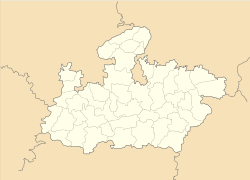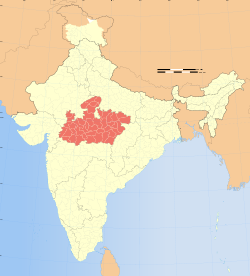Jabalpur
| Jabalpur जबलपुर | |
|
|
|
| Coordinates | |
| Country | |
| State | Madhya Pradesh |
| District(s) | Jabalpur |
| Mayor | Prabhat Sahu |
| Population • Density |
1.117.200 (2001[update]) • 110 /km2 (285 /sq mi) |
| Time zone | IST (UTC+5:30) |
| Area |
108.000 square kilometres (41.699 sq mi) • 411 metres (1,348 ft) |
Jabalpur (Hindi: जबलपुर) is a beautiful city in the state of Madhya Pradesh in India. Jabalpur is the administrative headquarters of Jabalpur district and Jabalpur division. Jabalpur is located in the Mahakaushal region in the geographic center of India. Jabalpur is one of the largest cities in Madhya Pradesh. Jabalpur was the 27th largest urban conurbation in India in 2001 (2001 Census).[1]
Jabalpur is one of the highest income tax paying cities in India since the headquarters of many important Central & State Departments are situated there and thousands of government employees are employed. Jabalpur also houses the Madhya Pradesh High Court. It was called Sanskardhani by Vinoba Bhave.
Contents |
Overview
Jabalpur is a beautiful city, located in the Mahakoshal region in the geographic center of India. Jabalpur is one of the largest city in Madhya Pradesh. It was the 27th largest urban agglomeration in India in 2001 (2001 Census).[1] On a global scale, Jabalpur was the 325th largest city or urban area in the world in 2006 [2] and Jabalpur it is estimated to be 294th largest city in the world by 2020. Jabalpur stands 120 in term of the fastest growing cities and urban areas in the world in 2006.Jabalpur city consists of Jabalpur Municipal Corporation, Jabalpur Cantonment, Khamaria township and Panagar Municipal Board. Jabalpur is the first district in India to have obtained the comprehensive ISO-9001 certificate. This has come into force from April 1, 2007.[3]
Jabalpur also houses the Madhya Pradesh High Court.It is known as the judicial capital of Madhya Pradesh. The principal seat of the Madhya Pradesh High Court is in Jabalpur. The numerous gorges in the neighbouring rocks surround the city with a series of lakes, which are shaded by trees and add much greenery to the suburbs. However, many of these lakes now have been encroached upon for the purpose of fishing or for building works, although the greenery still exists.
The city itself dates from the nineteenth century. It has a beautiful collection of Marble Rocks called Bhedaghat bordering the holy Narmada River.[4] Many visitors every year come to visit Jabalpur because of this major attraction. Jabalpur is zonal headquarters for the western central division of Indian railways.
Jabalpur has a big Defence and Military Centre - HQ of the MPBO Area, the headquarters of West Central Railway Zone,[4] the Madhya Pradesh State Electricity Board,[5] and the Madhya Pradesh High Courts.[6] It is also known for housing spiritual leaders like Maharishi Mahesh Yogi of Transcendental Meditation and Bhagwan Rajneesh.[4]
History
The name of the city Jabalpur comes from a combination of the Arabic word Jabal= Mountain and the Sanskrit word Pura = city. Jabal is also the root word in the name of Gibraltar which was originally called Jebel al Tariq (Tariq's Mountain). It is believed that Jabalpur is the tapasya bhumi of a mythological figure known as sage Jabalie, from whom the name Jabalpur is derived. Ashokan relics have been found. Later on it was the capital of the famous Tripuri kingdom in the (9th–10th centuries):-
- The Haihayas and Gonds.
In AD 875, it was taken over by the Kalachuri dynasty who made Jabalpur their capital. In the 13th century, the Gonds seized it and made it their capital. Inscriptions record the existence during the 11th and 12th centuries of a local line of princes of the Haihai people who are closely connected with the history of Gondwana.

In the 16th century the Gond raja of Garha-Mandla extended his power over fifty-two districts, including the present Jabalpur. During the minority of his grandson, Asaf Khan, the viceroy of Kara Manikpur, conquered the Garha principality and held it at first as an independent chief. Eventually he submitted to the Mughal emperor Akbar. From time to time, the Mughal rulers tried to overrun it. The legendary Gond Queen Rani Durgavati also died fighting the Mughal forces led by the great Mughal Emperor Akbar.
- The Marathas.
The Mughal Empire, however, enjoyed little more than a nominal supremacy; and the princes of Garha-Mandla maintained a practical independence until their subjugation by the Maratha governors of Sagar in 1781. In 1798 the Maratha Peshwa granted the Narmada valley to the Bhonsle princes of Nagpur, who continued to hold the district until the British occupied it in 1818 after defeating the Marathas. The British made Jabalpur the commission headquarters of the Narmada territories and established a cantonment here.
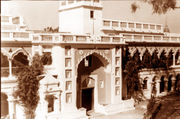
- The Transitions.
Rajman-Rajeshri Beohar Raghuvir Simha, born 1877 died 1960, was the last Jagirdar of Juppulpore to whose ancestors the estates were granted in 1764 in perpetuity by descendents of Rani Durgavati for acts of nationalism, patriotism, bravery in the battlefield in wars against Muslim invaders. His ancestor Rajman-Rajeshri Beohar Adhar Simha was Rani Durgavati's Prime Minister and her army's Knight-Commander who attained matyrdom fighting Akbar's forces alongside her in the battle of Narrai. Due to a very strong hold amongsts the masses, the hereditary title-prefix of "Beohar" and the Jagirdari were respected by the subsequent Bhoslas of Nagpur, the Peshwas of Saugor, and eventually the British who later became hostile due to the family's patriotism. In memory of Rajman-Rajeshri Beohar Raghuvir Simha, Civil Lines (North) is known as "Beohar Bagh" and the road between Collectrate and Adhartal is known as "Beohar Raghuvir Sinha Road".
- British Raj.
Under the British Raj, Jubbulpore became the capital of the Saugor and Nerbudda Territories, which was part of the British North-Western Provinces. At that time it became infamous for the Thuggee murders, but made more famous by the man who suppressed thugee, William Henry Sleeman, who was later appointed commissioner at Jabalpur. Very few know that the actions against the "Thugs" or "Phasigaars" were actually initiated by Rajman-Rajeshri Beohar Dariyav Simha, the then Jagirdar of Jubbulpore, who then handed it over to W.H. Sleeman (then Major). For the noble cause of rehabilitation of thugs' families who were called "gurinds", the Beohar-family allowed their piece of land known as "Gurandi" in the heart of the town.
- Dawn of Indepence Movement 1857.
In Jubbulpore, the first sparks for struggle for Indian independence from the British Raj were lit by Gadadhar Tiwari on 16 June 1857 when he opened fire on his European superiors. He was later blown publicly from the mouth of a canon. His supreme sacrifice did not go waste as the movement caught momemtum in the region, albeit, was short lived. It broiled for more than four months during which the British were petrified, became extremely vulnerable and dreaded the worst. They ran out not only of support but also of supplies and were besieged in their own citadels. They survived only because a local banker/merchant came to their rescue which bought them time for reinforcements to arrive. The 1857 struggle was locally spearheaded by gond Raja Shankar Sahi and his son Yuvraj Raghunath Sahi who were later arrested and detained in a jail which still exists near DRM office. The movement culminated tragically following martyrdom of Raja Shankar Sahi and Yuvraj Raghunath Sahi from the mouth of a canon on 18 September at the very spot where Lady Elgin Hospital now stands. Subsequently, their supporters and masterminds Jagat Singh Rajput, Beohar Aman Simha, Ganga Mishra, Sooraj Prasad and others went underground and never surfaced. Their estates and assets were confiscated.
- End of 19th Century CE.
The Saugor and Nerbudda Territories became part of the new Central Provinces in 1861 which in 1903 became the Central Provinces and Berar. By the early 20th century CE, Jubbulpore became the headquarters of a brigade in the 5th division of the Southern Army.
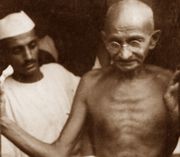
- Gandhian Era.
Mahatma Gandhi's longest and most important stay in Jubbulpore was in 1933 at the "Beohar Palace" of Beohar Rajendra Simha. Bapu was accompanied by Jawaharlal Nehru, Vallabhbhai Patel, Khan Abdul Ghaffar Khan, Dr Mukhtar Ahmed Ansari, Khurshed Nariman, Abul Kalam Azad, Jamnalal Bajaj, Dr Syed Mahmud, etc., and a meeting of AICC/CWC was held at the "Beohar Palace". Mahatma Gandhi's memorabilia of that occasion are still well preserved by the descendents of Beohar-family represented by Beohar Dr Anupam Sinha.
Many freedom fighters voluntarily gave up comforts of life and family and plunged into Gandhiji's three-S (swadeshi, swaraj and satyagrah) movements and the freedom struggle at large. In the wake of India's independence and nation building, they happily and gracefully embraced the harshes of long jail-sentences. Such bravehearts from Jubbulpore included Ravishankar Shukla, Sunderlal Tapasvi, Beohar Rajendra Simha, Laxman Singh Chauhan, Seth Govind Das, Harihar Vyas, Maheshdatt Mishra, Deviprasad Shukla, Subhadra Kumari Chauhan, Hukumchand Narad, Makhanlal Chaturvedi, Balmukund Tripathi, Dwarka Prasad Mishra, Kunjilal Dubey, Narsinghdas Agrawal, Rameshwarprasad Guru, Bhawaniprasad Tiwari, Kashiprasad Pandey, Nathuram Vyas, Chidambaram Pillai, Sawaimal Jain, Satyendra Mishra, Sitaram Jadhav, Mulayamchand Jain and many-many more..
An important landmark event was the holding of the Tripuri Congress session in 1939 that was presided over by Subhash Chandra Bose. Politically under Lokmanya Tilak's direction Jhanda Satyagraha was launched with success (who visited 3 times) Mahatma Gandhi visited 4 times and famous Congress session was held at 'Vishnudatt Shukla Nagar' at TilwaraGhat (near Jubbulpore) in 1939 when Subhash Chandra Bose was elected the Congress President against the wishes of Mahatma Gandhi. A memorial Kamania gate was erected in city.
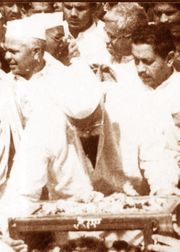
- Post Independence.
After India's independence in 1947 Jubbulpore started being spelt Jabalpur. Like any other city, Jabalpur also mourned Mahatma Gandhi's mytyrdom in 1948. Because of Bapu's strong linkages with Jabalpur and a very special love for it, his mortal remains were brought to the city. After going through the entire city, the urn containing Mahatma Gandhi's ashes were immersed in holy river Narmada by Pt. R.S. Shukla, Beohar Rajendra Simha, Seth Govindas and others on 12 February 1948 in TilwaraGhat where a massive unprecedented condolence meeting was held and addressed by these national leaders, great freedom-fighters and Gandhian-philosophers from Jabalpur. In 1950-51, the Central Provinces and Berar became the Indian state of Madhya Pradesh and Pandit Ravi Shankar Shukla became the first Chief Minister of a Congress led Government.
Geography
Jabalpur is located at .The central point of India is located in Jabalpur district. It has an average elevation of 411 metres (1348 feet).
The map of Jabalpur can be seen here at [7]
Topography
The exceptional Topography of Jabalpur with hills all around the city gives it a picturesque setting. Some Hindi movies like Jis desh main ganga behti hai, Ashoka etc. have been shot here. The picturesque setting though is a nightmare for town planners and developers. The Central Railways has constructed railway lines winding along these hills, somewhat akin to a horseshoe. The hills of Jabalpur, with varied mineral content are a popular destination for Geologists and Archaeologists. Palaeontologist, with the finding of a fossilised Dinosaur in the area.
The topography of Jabalpur is unique. The city is surrounded by low, rocky, and barren hillocks. Some of which form a barrier for continuous development of urban form and restrict inter-links between various parts of the city. Kariapather hillock to the north-east, Sita Pahad and Kandhari hills to the east, Madan Mahal hills and rocks outcrops to the south-west. Railway line girding the city like a "horse shoe" had its due influence in the growth of urban form. The main water reservoir of Khandari and Pariyat are located to the north-east direction of the city. Recently water is also drawn from Narmada River by Public Health Dept.
The main crops are wheat, rice, pulses, oilseeds, maize etc. Nearby is Bargi Dam on the river Narmada for irrigation, water supply and power generation. The town is surrounded by several lakes and water tank used for culture in them and in rivers. Besides the area is rich in limestone, refractory clay, bauxite, iron ore, manganese and other deposits. Three Cement plants several fireclay refractories lime stone kilns and good industrial estates nearby. Beside defence factories like GCF, Vehicle factory, G.I.F. and Ordnance factory depot.
Climate
| Jabalpur | ||||||||||||||||||||||||||||||||||||||||||||||||||||||||||||
|---|---|---|---|---|---|---|---|---|---|---|---|---|---|---|---|---|---|---|---|---|---|---|---|---|---|---|---|---|---|---|---|---|---|---|---|---|---|---|---|---|---|---|---|---|---|---|---|---|---|---|---|---|---|---|---|---|---|---|---|---|
| Climate chart () | ||||||||||||||||||||||||||||||||||||||||||||||||||||||||||||
|
||||||||||||||||||||||||||||||||||||||||||||||||||||||||||||
|
||||||||||||||||||||||||||||||||||||||||||||||||||||||||||||
Jabalpur has a sub-tropical climate, more specifically a humid subtropical climate, typical of North-Central India. Summers start in late March and last up to June. May is the hottest month with average temperature's near 45 C . They are followed by the monsoon season, which lasts uptil early October, with a total precipitation of nearly 55 in (1386 mm). Winters start in early November and last until early March. They peak in January with average temperatures near 7 C .
Demographics
As of 2001[update] India census,[8] Jabalpur had a population of 1276853. Males constitute 52% of the population and females 48%. Jabalpur has an average literacy rate of 75%, higher than the national average of 59.5%: male literacy is 79%, and female literacy is 70%. In Jabalpur, 12% of the population is under 6 years of age. Jabalpur is among the cities having Million plus population in India according to the 2001 Census.
Population has risen as village folk migrate in, often settling in slums on the outskirts of Jabalpur. By 2015 estimates are that the city will double to two million people. Listed population of the city further increased with setting up of Central government units.
Economy
Jabalpur district with River Narmada bringing in fresh water from the Vindyachal Ranges has developed into an agrarian economy. The land of the Narmada basin with its fertile alluvial soil gives good yields of sorghum, wheat, rice and millets in the villages around Jabalpur. The State of Madhya Pradesh is the largest producer of Soybeans and the district of Jabalpur occupies a place of pride in agriculture production.
Important among commercial crops are pulses, oilseeds, cotton, sugar cane and medicinal crops. The state is poised for a breakthrough in soybean cultivation. In the state Kharif crops occupy 60% and Rabi crops 40% area with 71.4% area under food grain production. Nearly 59% of landholders are marginal whereas small farmers share 18% of farmland. Low literacy (35.45%), undulating topography, large waste land (13.2%), under developed irrigation potential (23%), low ground water utilization, large proportion of rain fed agriculture (75%), practice of Kharif fallows (3.6%), low cropping intensity (131%), low fertilizer consumption (50 kg/ha), high proportion of low value crops, and high population of low productive live stock are the major constraints of the state.
Jabalpur has a variety of Industries too. Most of these have their bases in mineral substances of economic value found in the district. Ready-made garments industry is one of the most popular and profitable business in Jabalpur. Bidi manufacturing, lime stone related industries, Electrical goods, Saw mills, Food Processing Industries are the major business areas in this region. Some other industries are Telephone Parts, Furniture, Building Materials, Ammunitions and glassware.
The Defence establishments started in the early 20th century. Jabalpur has four Ordnance Factories. The Gun Carriage Factory was started in the year 1904 well equipped and manufacture gun parts, mounting, shells and a variety of the other product for war purpose. Vehicle Factory Jabalpur (VFJ)[9] was started as manufacturer of trucks named SHAKTIMANN. Other two are Grey Iron Foundry (GIF) and Ordnance Factory Khamaria (OFK)[9].
Armed forces make a large portion of the city and economy in this city. City has three regimental centres, Grenadiers, Jammu and Kashmir rifles and the Signals regiment.
Jabalpur also has Head quarter of Madhya Pradesh State Electricity Board, Homeguards and many other State and Central Government Offices. Telcom Factory, Telcom Training Centre, Survey of India are some important offices.
- Revenue Layout[10]
Jabalpur is an important Divisional Headquarters having 8 districts namely Jabalpur, Seoni, Mandla, Chhindwara, Narsimhapur, Katni, Dindori, Balaghat. The Jabalpur District has been reconstituted on May 25, 1998. It now has four tehsils Jabalpur, Sihora, Patan and Kundam.
There are 7 Blocks in the district with 1449 inhabited villages, 60 uninhabited, 1209 revenue villages and 4 forest villages.
Culture
The presence of the Narmada and the rule of Gond and Maratha dynasties has made Jabalpur a primarily Hindu dominated area. The Mughal rule brought in a sizable Muslim population. The city has seen the worst form of Hindu Muslim riots in the 60s.
Language
Hindi is the first language of the state and spoken and understood in the city. The Mughals brought Urdu and the influence of Maratha rulers has given Marathi to the multilingual culture of Jabalpur.
Transportation
Jabalpur is well connected by road, rail and has a single route air connectivity.
Air
Jabalpur Airport (IATA Code: JLR) is known as DUMNA Airport and is about 20 km from city. Kingfisher airlines via its Kingfisher red service ATR aircraft is providing one daily non-stop service on the Jabalpur-New Delhi route. This flight also provides connection to other cities like Mumbai, Ahmedabad, Kolkata , Hyderabad, Banaglore and Chennai via New Delhi. Indian Airlines runs four days a week non-stop service on the New Delhi-Jabalpur route and provides connection to other cities via New Delhi.
Kingfisher Red: Delhi Indian Airlines: Delhi.
Road
Jabalpur is well connected to Nagpur, Bhopal, Allahabad and Jaipur so you can travel easily by roads also.Jabalpur is well connected to Mandla for every ten minutes there is a state bus. The city is connected with three National Highways
- NH 7 (Varanasi-Kanyakumari)longest National Highway in India which goes from Varanasi in Uttar Pradesh to the southernmost tip of India, Kanyakumari in Tamil Nadu.[11]
- NH 12 (Jabalpur-Jaipur)[12]
- NH 12A (Simga, Chattisgarh- NH 26 near Jhansi),[13]
Railways
Jabalpur is the headquarters of West Central Railways and is well connected with mail and super-fast trains from Mumbai, New Delhi, Ahmedabad, Bhopal, Gwalior, Kolkata, Raipur, Vadodara, Patna, Guwahati Lucknow, Chennai, Bangalore, Nagpur, Pune, Jaipur, Jammu, Hyderabad, Surat, Varanasi, and Goa. Apart from broad-gauge railways, Jabalpur is notable for having narrow-gauge railways (which connect with Gondia). Work to convert this Gondia-Nainpur-Jabalpur narrow gauge to broad gauge has been started under Project Unigauge [14] and will provide new opportunities as southern India will be reachable quickly. Gondia Jabalpur was the first of the trains started by British government. It passes through beautiful mountains, valleys and forests on its way. Many trains are offering services from Jabalpur Station.
Local transport
Jabalpur, the city of marbles, is fast emerging as a center of trade and commerce in the state of Madhya Pradesh. In the context of rapid growth of the city, increasing mobility, high travel demand, increasing intensity of traffic, congestion, delays, accidents and other such problems, public mass transport system of the city stands out as the most critical issue. The intra-city public transport system is essentially road based with 110 private mini buses and 250 tempos and 10,000 auto rickshaws.Other than that Mini Buses, Autos, Tempos enable good and cheap transportation in the city. Cycle Rickshaws are also helpful in local routes which are quite cheap and eco-friendly and constitute the main source of transportation. Since there was no specialized and effective regulatory agency to monitor the system a special purpose vehicle in the form of public limited company Jabalpur City Transport Services Limited has been set up to operate and manage the public transport system in Jabalpur with PPP model to overcome financial constraints. On this PPP model very comfortable low-floored GPS enabled Star-Buses fleet called as METRO BUS FACILITY have been introduced sice year 2005 and have been running very successfully. Recently,Radio-Cab service has also been introduced in the city sice end of year 2009.The 24 hour Radio cab service is called as METRO TAXI,which are GPS enabled cars and can be booked through a phone call. Customer Service number for METRO TAXI is 0761-4055555.
Media
Both the print media and the broadcast media are actively involved in the process of enlightening people on all matters of national as well as global importance.[15]
Magazine - Kalawardhan Magazine in Hindi and Marathi for Performing Arts {A National Level Magazine}
Newspapers
The Jabalpur media houses employ journalists who provide a comprehensive coverage of all the important news. Although the popular English and Hindi newspapers of India are available in the city, the local Hindi newspapers record the maximum readership. The local newspapers issued, that have a large circulation include the following:
- Dainik Bhaskar
- Swatantramat
- Nai Duniya
- Raj Express
- Haribhumi
- The Hitavada
- Nav Bharat
- Daily Deshbandhu
- Patrika
- People Samachar
- Yash Samachar
- Nazi Samachar
Radio
The radio channels available in Jabalpur include
- MY FM 94.3 Tag Line : Jiyo Dil se! www.myfmindia.com
- Radio Mirchi 98.3 FM Tag Line : Its Hot!
- Radio Dhamaal 106.4 FM
- Red FM 93.5 Tag Line : Bajate raho..
- Akashvani 102.9
- Gyan Vani 105.6
Tourism
- BhedaGhat - Marble Rocks.[16]
This small village of Jabalpur district situated on the banks of river Narmada and widely famous for its marble rocks is at a distance about 25 km from Jabalpur by road. Soaring in glittering splendour, the marble rocks at Bhedaghat rise to a hundred feet on either side of the Narmada. The serene loveliness of the scene is one of cool quiet, the sunlight sparkling on the marble-white pinnacles and casting dappled shadows on the pellucid waters. In his Highlands of Central India Captain J. Forsyth speaks eloquently about the infinitely varied beauty of the rocks.
The eye never wearies of the . . . effect produced by the broken and reflected sunlight, now glancing from a pinnacle of snow-white marble reared against the deep blue of the sky as from a point of silver, touching here and there with bright lights the prominence of the middle heights and again losing itself in the soft bluish grays of their recesses.....Here and there the white saccharine limestone is seamed by veins of dark green or black volcanic rock; a contrast which only enhances like a setting of jet, the purity of the surrounding marble.
The famous BhedaGhat and Dhuandhar has served as a beautiful site for shootings of movies like Jis Des Mein Ganga Bheti Hai, Asoka etc. The area also serves as a source of marble, the marble statues and sculptures made by local sculptors are famous throughout the country.
- Dhuandhar[16]
The famous waterfall is located just 25 km from Jabalpur. The Narmada making its way through the Marble Rock's narrows down and then plunges in a waterfall known as Dhuandhar or the smoke casade. So powerful is the plunge that its roar is heard from a far distance. The falls and the breaking of the volume of water at the crest present an awesome spectacle of Nature's power unleashed.
- Chausath-Yogini (Sixty Four female Yogis).[16]
Situated atop a hill rock and approached by a long flight of steps,the Chausath-Yogini Temple commands a singularly beautiful view of the Narmada flowing through the jagged gorge of Marble Rocks in Bhedaghat. Dedicated to Lord Shiva, this 10th century temple has exquisitely carved stone figures of deities belonging to the Kalchuri period. According to a local legend, this ancient temple is connected to the Gond Queen Durgavati's palace through an underground passage.
- LamhetaGhat.
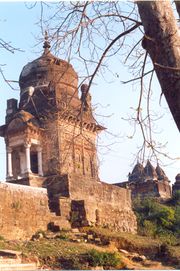
A "must-visit" place for those interested in history, religion, photography, or just simply picnicing (veg foods are OK; a holy place) at a peaceful location. Beautiful view of Narmada river from the holy temples, especially at dusk. The holy location is few kilometers upstream of the Marble Rocks which is accessible from the Dhuadhar Waterfall as well as Tilwara-Medical bypass. It is said that last rites performed here has same significance as at Gaya. There is also a shani kund, extremely beneficial to those affected by Shani-Dev. Most importantly, there are several beautiful and historic temples constructed by the Beohar dynasty between 16-18th century CE, including the till-top Radhika-Madhav Temple (also referred-to as Radha-Krishna/Radha-Govind Temple), Shiv-Bhaskar (also known as Shiv-Surya Temple), Lambodar-Siddhivinayak, Ram-Janki, Mekalsuta-Reva, Kadambari-Sharda, Batuk-Bhairav, and Marutinandan-Anjaneya Temples. The entire temple complex, housing about 6-7 temples and a dharmshala on the banks of Narmada, is collectively referred-to as "Shankarji Maharaj Mandir Parisar" because Shiv-Bhaskar temple is the main one. Following the earthquake of 1997, some of these are delapidated whereas others have been repaired and/or renovated. While the temples are of Beohar family-owned and family-operated private trust "Sri Radhakrishna Charitable Private Trust" Managing-Trustee Beohar Dr Anupam Sinha, the local custodianship is under the family priest Pandit Santosh Dubey ji maharaj. Some tiling and landscaping work on the river bank has recently been completed by the Narmada Valley Development Authority and by MP Tourism making it more practical and convenient to visit.
- TilwaraGhat
From where Mahatma Gandhi's ashes were immersed in the Narmada by Beohar Rajendra Simha, Pandit Ravishankar Shukla, Laxman Singh Chauhan, Seth Govindas, Dwarka Prasad Mishra, etc., and venue of the open session of the Tripuri Congress in 1939.
- Rani Durgavati Memorial and Museum.
Dedicated to the memory of the great Queen Durgavati is her memorial and a museum which houses a fine collection of Sculptures, Inscriptions and Prehistoric Relics.
- Bargi Dam.
It is a multipurpose project on river Narmada. It's also a tourist spot, Local authorities have started a cruise boat which runs on the reservoir of Bargi dam.

- Shaeed Smarak (Matyrs' Memorial)
A historic and monumental circular building in what was known as Gole-Bazar during British times and also as Wright Town. Shaheed Smarak is known the world over for its breathtaking fresco (murals or wall-paintings) by the internationally acclaimed artist Beohar Rammanohar Sinha and his colleagues from Santiniketan on the walls, balcony, parapet and gigantic dome. The central theme of the frescoes is India's war of independence fought between 16th and 19th century AD, starting with Rani Durgavati gearing-up against Moghul Emperor Akbar's attack on Gondwana (now Jabalpur and Mandla). Painted by the famous Beohar Rammanohar Sinha, this is the first painting ever made on Rani Durgavati. Dr Rajendra Prasad and Pandit Jawaharlal Nehru visited Jabalpur for the laying of foundation stone and for the inauguration of Shaheed Smarak. The idead of provincial congress committee in 1950s was to construct an auditorium in the shape of a miniaturized version of Delhi's Parliament House with a hall in the middle, a corridor running around it, and rooms for art and cultural activities, art gallery, library, etc., in the periphery. As the then President of PCC, Seth Govindas got the Shaheed Smarak completed very efficiently and well on time. It is currently being looked-after by a Public Trust.
- D. B. Vallabh Das Palace
A historic building in the old city area of Hanuman Tal is residence of Malpani family of Jabalpur. It is worth a visit for its architecture, murals and wall paintings.
- MadanMahal Bastion
Built by the Gond ruler Maharaja Madan Sahi, in 1116 atop a rocky hill, the fort dominates the skyline and provides a panoramic view of the town and the country side around it.
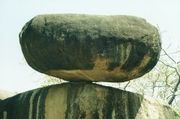
- Balancing Rocks
Jabalpur is also famous for eroded volcanic rock formations called as Balancing Rocks of Jabalpur. This rock is situated near the base of Madan Mahal Fort, in Deotal in a place called Shailparna.
- SangramSagar and BajnaMath
These medieval constructions were built by the famous Gond King Sangram Shah between 1480-1540.
- Water Works
Small wild life reserve and old dam on the way to Dumna airport.
- Beohar House
Construsted soon after completion of the building which now houses the High Court of MP, this private manor has had the honour of hosting several visiting luminaries including Mahatma Gandhi, Dr. Rajendra Prasad, Jawaharlal Nehru, Vinoba Bhave, Osho (Bhagwan Shree Rajneesh), Khan Abdul Ghaffar Khan or Bacha Khan, Madeleine Slade or Mirabehn, Jamnalal Bajaj, Maithili Sharan Gupt, Shankar Dayal Sharma, Kaka Kalelkar, Thakkar Bapa, Makhanlal Chaturvedi, Somnath Hore, A. Perumal, Maharshi Mahesh Yogi, Medha Patkar, Nirmal Verma, Rehman, etc. History books of early 1820-1830s refer to this area as Jamnera and subsequently 'Beohar Grove' which was later converted to Civil Lines by the British. When the railway line was laid, it bisected the area into North and South, and this area became Civil Lines (North). This entire area is now popularly referred-to as 'Beohar-Bagh' which means Garden of the Beohars'.
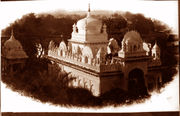
- RadhaKrishna Temple-Complex incorporating the Shiva Temple (Beohar-dynasty)
Historic temples in several ways, these Vaishnav and Shaiva temples in old city Jabalpur were constructed by Beohar-dynasty in c. 17-18th century CE and boast to be the first renaissance temples inasmuch as these were one of the first series of temples in India to be opened to the Harijan (outcaste) in 1929 by Beohar Raghuvir Sinha with his friends Ghanshyam Das Birla and Jamnalal Bajaj. These great leaders visited Jabalpur on the occasion. The RadhaKrishna temple houses the idols of Shri Radha-Krishna (gifted by Maharaja Chhatrasal of Panna to the ancestors of Beohar-dynasty, supposed to be replicas of the idols of Bhagwan JugalKishore ji) along side Shri Ram-Janki ji and several other Gods and Goddesses.
- Bandhavgarh National Park
This nearby national reserve forest has the highest density of tigers in the world, making it a good place to see a tiger in its natural habitat. It is in this valley where the white tiger was discovered. For tourists, Nature Heritage, Bandhavgarh Madmouse and GTV Resort Phone No. 07627 265314 are some good lodging options. There are many other resorts in Bandhavgarh as well.
- Kanha National park
Jabalpur is nearest big city to go to Kanha National Park which is one of the biggest national parks in India and has the distinction of successfully implemented Project Tiger, as tiger conservation program in India. Every year the park attracts large number of tourists for watching tigers from close proximity. For more details check http://www.kanha.in/Kanhanational%20Park.htm
- Pench National park
The park is home to the cute character Mowgli in Sir Rudyard Kipling's noble prize winning creation Jungle Book. Jabalpur also has Bandhavgarh national reserve forest very close to Pench, and well connected through road.
- Marble Rocks
Just 21 km west of Jabalpur, is a small village called Bhedaghat. The village is world famous for splendid Marble Rocks on the banks of Narmada River. Covered with dark volcanic seams of green and black, they tower to almost 100 ft above the soft flowing Narmada on either side. They are fabulous to look at during the daytime when sun sparkles on the pure white surfaces of these rocks. During the night as well, they give you a mesmerizing view under the moonlit skies. The Marble Rocks have been considered as one of the thousand places that you should see before you die. The best way to enjoy the sheer charm of these rocks is by taking a boat ride in Narmada.
- Beohar Sarovar
A private-owned beautiful reservoir, also known popularly as "BurhanSagar" alongside NH7 (Jabalpur-Sihora section) about 20-25 km from Jabalpur. It was the summer retreat of the Beohars (ex-Jagirdars of Jabalpur) which remains full of water all year round with lots of natural Indian lotuses. It is also frequented by migratory birds and is a roving-avian haven. The natural flow of rain water has been stopped by piling-up earth and lining the ridge with stone blocks thereby creating a reservoir. Several centuries ago, the construction was supervized by one Burhan Shripaal who worked for the Beohar-family, hence the names "BeoharSarovar" and also "BurhanSagar". The village Burhagarh is located on a hillock on top of which stood Haveli of the Beohars. As a guest of Beohar Rajendra Simha in 1933, Mahatma Gandhi stayed here. Beohar Rajendra Simha subsequently named the village "GandhiGram".
- KachnarCity
It is locality in Vijayanagar suburb of Jabalpur and is famous for about 70 feet high Lord Shiva statue which houses a cavern with replicas of Shivalingam from important holy shrines of Lord Shiva all over country.
Snooker
The game of Snooker was conceived in Jabalpur. Origins of the game of Snooker are generally regarded as being in the latter half of the 19th century. Billiards had been a popular activity amongst British army officers stationed in India who stole the idea from the Indian game Carrom, and variations on the more traditional billiard games were devised. One variation was to add coloured balls in addition to the reds and black which were used for pyramid pool and life pool. This gave birth to the game of Snooker. Although snooker's origin is not recorded explicitly, it is generally held that a Colonel Sir Neville Chamberlain (no relation to the World War II Prime Minister) conceived the game in the British Army Officer's Mess in Jubbulpore, India, in 1875.[17]
Artists
Jabalpur is known to be a city of culture SANSKARDHANI which is full of artists, writers and talents. Some of them have been accorded highly significant international accolades, including -
- Prof. Beohar Rammanohar Sinha - Maestro (painter) who illustrated the CONSTITUTION OF INDIA, Shaheed Smarak, etc.
- Prof. RoopKumar Soni - well known Sitar player,
- Prof. GyanRanjan - Litterateur.
A few National level artists from Jabalpur are -
- Rajnikant Trivedi - Comedian,
- Anil Moghe - well known Tabala Player,
- Mrs. Mohini Moghe - well known Kathak Dancer,
- Dr. Bhaskar Khandekar - Classiacl Violin Player and India's First Music Therapist, [18]
- Dr. Akhilesh Sapre - well known Sitar Player,
Famous writers from Jabalpur are -
- Harishankar Parsai - Satirist and founder of Vivechna,
- Makhanlal Chaturvedi - spent significant period of time in Jabalpur (though not from Jabalpur),
- SubhadraKumari Chauhan - Poet who is famous for Khoob ladi mardani wo to Jhasi wali rani thi..,
- Beohar Rajendra Simha - Litterateur,
- Amritlal Vegad - Narmada travelogue writer and collage-maker,
- Seth GovindDas - Litterateur.
Shopping
Main shopping area's For Cloths:Ganji pura,Bada fuhara,Sadar,Gorakhpur market. Gold:Sarafa.. Malls: The Bigbazar Mall, Vishal Mega Mart , Relaince Fresh and Samdaria Mall are the big shopping centers in Jabalpur.
Education
People in Jabalpur are growing very fast in terms of education. We find more than 10 engineering coleges in Jabalpur such as SGBM institute of technalogy and science,Gyan ganga college,Hitkarni college,Takshila college. The Girls are educated same as boys.There are many schools in jabalpur such as Model Higher Secondary School, christchurch senior secondary school, St. Xavier's , Gyan ganga international school, MGM higher secondary school, Satya Prakash school, Khalsa School, Saraswathi Vidhya Mandir
Besides academic education there are few Institutions for Music and Performing arts such as – • Bhatkhande Sangeet Mahavidyalay • Sharada Sangeet Mahavidyalay • Kalawardhan Academy of Performing Arts
Temple
Badsha Halwai Mandir ,Ganesh Mandir,Tripur sundari Temple, Laxmi Narayan Mandir,Bajna Math,Sharda Mandir tripuri chauk ,Barela Mandir Khermai Temple.
References
- ↑ 1.0 1.1 "List of Million Plus Urban Agglomerations Cities". Des.delhigovt.nic.in. http://des.delhigovt.nic.in/Census2001/urbanplus.htm. Retrieved 2010-09-01.
- ↑ [1] Census
- ↑ Government of India - Districts of Madhya Pradesh - Jabalpur - CM Anudan
- ↑ 4.0 4.1 4.2 "JabalpurCity, Jabalpur city, Jabalpurcity.com, Jabalpur, Madhya Pradesh, M.P. India". Jabalpurcity.com. http://www.jabalpurcity.com/. Retrieved 2010-09-01.
- ↑ Madhya Pradesh Portal
- ↑ "High Court Of Madhya Pradesh : Jabalpur". Mphighcourt.nic.in. http://mphighcourt.nic.in/. Retrieved 2010-09-01.
- ↑ "Jabalpur on". Mapmyindia.com. http://mapmyindia.com/index.html?app=&q%3Dmap%26addr%3Djabalpur%26sta%3DMP&x=-1111892&y=5575669&z=7&licKey=ed24f1c04c6562b128091ad1a7ec58e2. Retrieved 2010-09-01.
- ↑ "Census of India 2001: Data from the 2001 Census, including cities, villages and towns (Provisional)". Census Commission of India. Archived from the original on 2004-06-16. http://web.archive.org/web/20040616075334/http://www.censusindia.net/results/town.php?stad=A&state5=999. Retrieved 2008-11-01.
- ↑ 9.0 9.1 "Indian Ordnance Factories: Our Factories". Ofbindia.gov.in. http://ofbindia.gov.in/index.php?wh=ourunits. Retrieved 2010-09-01.
- ↑ "Government of India - Districts of Madhya Pradesh - Jabalpur - About us". Jabalpur. 1998-05-25. http://jabalpur.nic.in/aboutus.htm#revenue. Retrieved 2010-09-01.
- ↑ [2] Drivig Directions NH 7
- ↑ Map of India Driving Directions for NH 12
- ↑ [3] National Highway 12A
- ↑ Railway Gazette International Supplement December 2007 p7
- ↑ "Jabalpur Media". Mapsofindia.com. http://www.mapsofindia.com/jabalpur/media/index.html. Retrieved 2010-09-01.
- ↑ 16.0 16.1 16.2 "Bhedaghat, Madhya Pradesh travel information guide, Dhuandhar Falls, places". Travelmasti.com. http://www.travelmasti.com/domestic/mp/bhedaghat.htm. Retrieved 2010-09-01.
- ↑ "The History of Snooker". Titansports.co.uk. http://www.titansports.co.uk/history/snooker.htm. Retrieved 2010-09-01.
- ↑ [19] www.indiasfirst.com
![]() This article incorporates text from a publication now in the public domain: Chisholm, Hugh, ed (1911). Encyclopædia Britannica (Eleventh ed.). Cambridge University Press.
This article incorporates text from a publication now in the public domain: Chisholm, Hugh, ed (1911). Encyclopædia Britannica (Eleventh ed.). Cambridge University Press.
External links
- Official Website
- information about Jabalpur
- Jabalpur travel guide from Wikitravel
|
||||||||
|
||||||||||||||
|
||||||||
|
|||||||||||||||||||||||||||||
